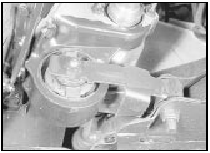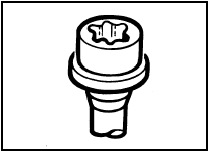
Peugeot 205 Manual
Cylinder head - removal and refittingXU series engine in-car repair procedures / Cylinder head - removal and refitting
Removal
1 Drain the cooling system as described in
Chapter 1.
2 Remove the timing belt as described in Section 4.
3 Slacken, but do not remove, the engine lower mounting rubber centre nut and bolt (see illustration).

8.3 Engine lower mounting
4 Remove the air cleaner assembly, inlet ducts and pipes with reference to the relevant Part of Chapter 4.
5 Remove the crankcase breather and its pipes.
6 Remove the nut which secures the engine right-hand mounting rubber to the cylinder head bracket (see illustration).

8.6 Right-hand engine mounting and cylinder head bracket
7 Carefully raise the engine 60 to 80 mm using a hoist or a well-protected jack. Remove the two bolts which secure the right-hand mounting bracket to the cylinder head, then lower the engine back into position.
8 Remove the inlet manifold and associated fuel system components with reference to the relevant Part of Chapter 4.
9 Make suitable notes as an aid to refitting then disconnect all coolant and vacuum hoses and electrical leads from the cylinder head.
10 Disconnect the exhaust downpipe(s) at the manifold flange.
11 Remove the coolant pipe from the pump inlet housing. Also remove the diagnostic socket from its bracket.
12 Remove the camshaft cover, at the same time removing the distributor cap and HT leads. If the cylinder head is to be dismantled for overhaul, remove the distributor or, on models with static distributorless ignition systems, the ignition module, as described in Chapter 5B.
13 Working in the reverse of the sequence shown in illustration 8.27, progressively slacken the cylinder head bolts by half a turn at a time, until all bolts can be unscrewed by hand. Remove the bolts along with their washers, noting the correct location of the spacer fitted to the front right-hand bolt.
14 With all the cylinder head bolts removed, the joint between the cylinder head and gasket and the cylinder block/crankcase must now be broken without disturbing the wet liners. Although these liners are better-located and sealed than some wet-liner engines, there is still a risk of coolant and foreign matter leaking into the sump if the cylinder head is lifted carelessly. If care is not taken and the liners are moved, there is also a possibility of the bottom seals being disturbed, causing leakage after refitting the head.
15 To break the joint, obtain two L-shaped metal bars which fit into the cylinder head bolt holes, and gently “rock” the cylinder head free towards the front of the car. Do not try to swivel the head on the cylinder block/crankcase; it is located by dowels, as well as by the tops of the liners.
16 When the joint is broken, lift the cylinder head away. Remove the gasket from the top of the block, noting the two locating dowels. If the locating dowels are a loose fit, remove them and store them with the head for safekeeping.
17 Do not attempt to turn the crankshaft with the cylinder head removed, otherwise the wet liners may be displaced. Operations that require the crankshaft to be turned (eg cleaning the piston crowns), should only be carried out once the cylinder liners are firmly clamped in position. In the absence of the special Peugeot liner clamps, the liners can be clamped in position as follows. Use large flat washers positioned underneath suitablelength bolts, or temporarily refit the original head bolts, with suitable spacers fitted to their shanks (see illustration).

8.17 Cylinder liners clamped with washers and bolts
18 If the cylinder head is to be dismantled for overhaul, remove the camshaft and cam followers as described in Section 7, then refer to Part D of this Chapter.
Preparation for refitting 19 The mating faces of the cylinder head and cylinder block/crankcase must be perfectly clean before refitting the head. Use a hard plastic or wood scraper to remove all traces of gasket and carbon; also clean the piston crowns. Refer to paragraph 17 before turning the crankshaft. Take particular care during the cleaning operations, as aluminium alloy is easily damaged. Also, make sure that the carbon is not allowed to enter the oil and water passages - this is particularly important for the lubrication system, as carbon could block the oil supply to the engine’s components. Using adhesive tape and paper, seal the water, oil and bolt holes in the cylinder block/crankcase. To prevent carbon entering the gap between the pistons and bores, smear a little grease in the gap. After cleaning each piston, use a small brush to remove all traces of grease and carbon from the gap, then wipe away the remainder with a clean rag. Clean all the pistons in the same way.
20 Check the mating surfaces of the cylinder block/crankcase and the cylinder head for nicks, deep scratches and other damage. If slight, they may be removed carefully with a file, but if excessive, machining may be the only alternative to renewal.
21 If warpage of the cylinder head gasket surface is suspected, use a straight-edge to check it for distortion. Refer to Part D of this Chapter if necessary.
22 Check the condition of the cylinder head bolts, and particularly their threads, whenever they are removed. Wash the bolts in suitable solvent, and wipe them dry. Check each for any sign of visible wear or damage, renewing any bolt if necessary. Measure the length of each bolt, to check for stretching (although this is not a conclusive test, in the event that all ten bolts have stretched by the same amount). Although Peugeot do not actually specify that the bolts must be renewed, it is strongly recommended that the bolts should be renewed as a complete set whenever they are disturbed.
23 Note that as from early 1987, the cylinder head bolts are of No 55 Torx type and 8 mm thick washers are fitted to these bolts, whereas 3 mm thick washers fitted to the earlier type hexagon head bolts (see illustration).

8.23 Torx type cylinder head bolts fitted to later models
The spacer fitted to the bolt at the timing belt end is 25 mm thick, (previously 23 mm), and is identified by a groove around its perimeter. A modified cylinder head gasket is also fitted to engines with Torx type cylinder head bolts, so it is important to quote the engine number accurately when obtaining a new one.
Refitting
24 Commence refitting by fitting the dowels to
the cylinder block. Keep the flywheel-end dowel
raised by inserting a 5 mm punch or large nail
through the hole in the front of the block (see
illustration). Remove the liner clamps.

8.24 Using a nail to hold the cylinder block dowel in the raised position
25 Fit the new gasket, dry, with the tab at the flywheel end. Lower the cylinder head into position, making sure that it mates with the dowels. Remove the punch or nail.
26 Fit the cylinder head bolts, their threads clean and lightly oiled. Remember to fit the spacer to the bolt at the timing belt end. When fitting the Torx type cylinder head bolts, apply a little molybdenum disulphide grease to their heads, and to the contact surface of their heads.
27 Progressively tighten the bolts in the order shown to the Stage 1 specified torque setting (see illustration).

8.27 Cylinder head bolt tightening sequence
Note that the torque
settings are different for the two cylinder head
bolt types; ensure that the correct setting is
being used according to bolt type.
28 Raise the engine slightly and refit the two bolts which secure the right-hand mounting bracket to the cylinder head. Tighten these bolts and slacken the one which holds the same bracket to the engine block. Lower the engine and tighten the right-hand mounting nut and the lower mounting rubber nut and bolt.
Engines with hexagon head type
cylinder head bolts
29 Slacken cylinder head bolt No 1, then
immediately retighten it to the Stage 2
specified torque. Tighten further by the angle
specified for Stage 3 using a socket and
extension bar. It is recommended that an
angle-measuring gauge is used during this
stage of tightening, to ensure accuracy (see
illustration). Repeat for all the bolts, following
the tightening sequence.

8.29 Home-made torque angle measuring gauge. Disc is fixed and pointer
rotates
30 Check the valve clearances and adjust, if necessary (see Section 2).
31 Refit the remaining components in the reverse order of removal. Make sure that the correct inlet manifold gasket is fitted. A gasket for carburettor versions is included in the gasket overhaul set which is not the same as the one for fuel injection models.
32 Refill and bleed the cooling system (Chapter 1).
33 Start the engine and warm it up until the cooling fan cuts in, then switch off and allow it to cool for at least two hours.
34 Retighten the cylinder head bolts, as described in paragraph 29, then recheck the valve clearances.
35 If a new timing belt has been fitted, refer to Section 4 and retension it if necessary.
36 Tighten the engine mounting bracket bolt.
Engines with Torx type cylinder head
bolts
37 Fully slacken all the head bolts, working in
the reverse of the tightening sequence. Once
the bolts are loose, tighten all bolts to their
Stage 2 specified torque setting, again
following the specified sequence.
38 With all the bolts tightened to their Stage 2 setting, working again in the specified sequence, angle-tighten the bolts through the specified Stage 3 angle, using a socket and extension bar. It is recommended that an angle-measuring gauge is used during this stage of tightening, to ensure accuracy. Note that no further tightening of the Torx type head bolts is necessary.
39 Check the valve clearances and adjust, if necessary (see Section 2).
40 Refit the remaining components in the reverse order of removal and with reference to the relevant Sections and Chapters of this manual as applicable. Make sure that the correct inlet manifold gasket is fitted. A gasket for carburettor versions is included in the gasket overhaul set which is not the same as the one for fuel injection models.
41 Refill and bleed the cooling system (Chapter 1).
42 If a new timing belt has been fitted, refer to Section 4 and retension it if necessary.
43 Tighten the engine mounting bracket bolt.






